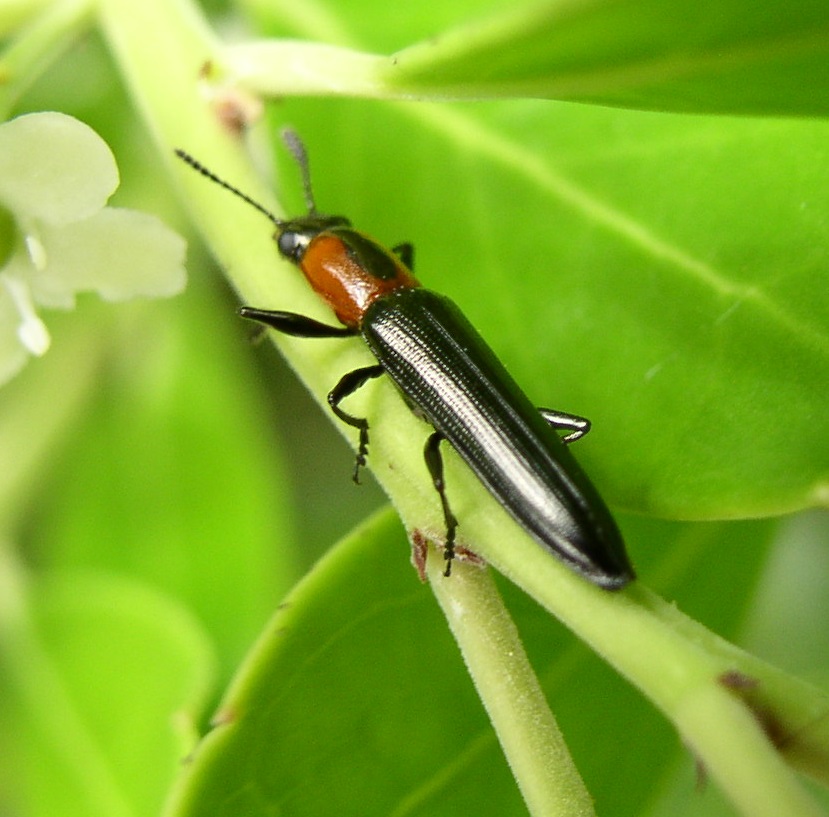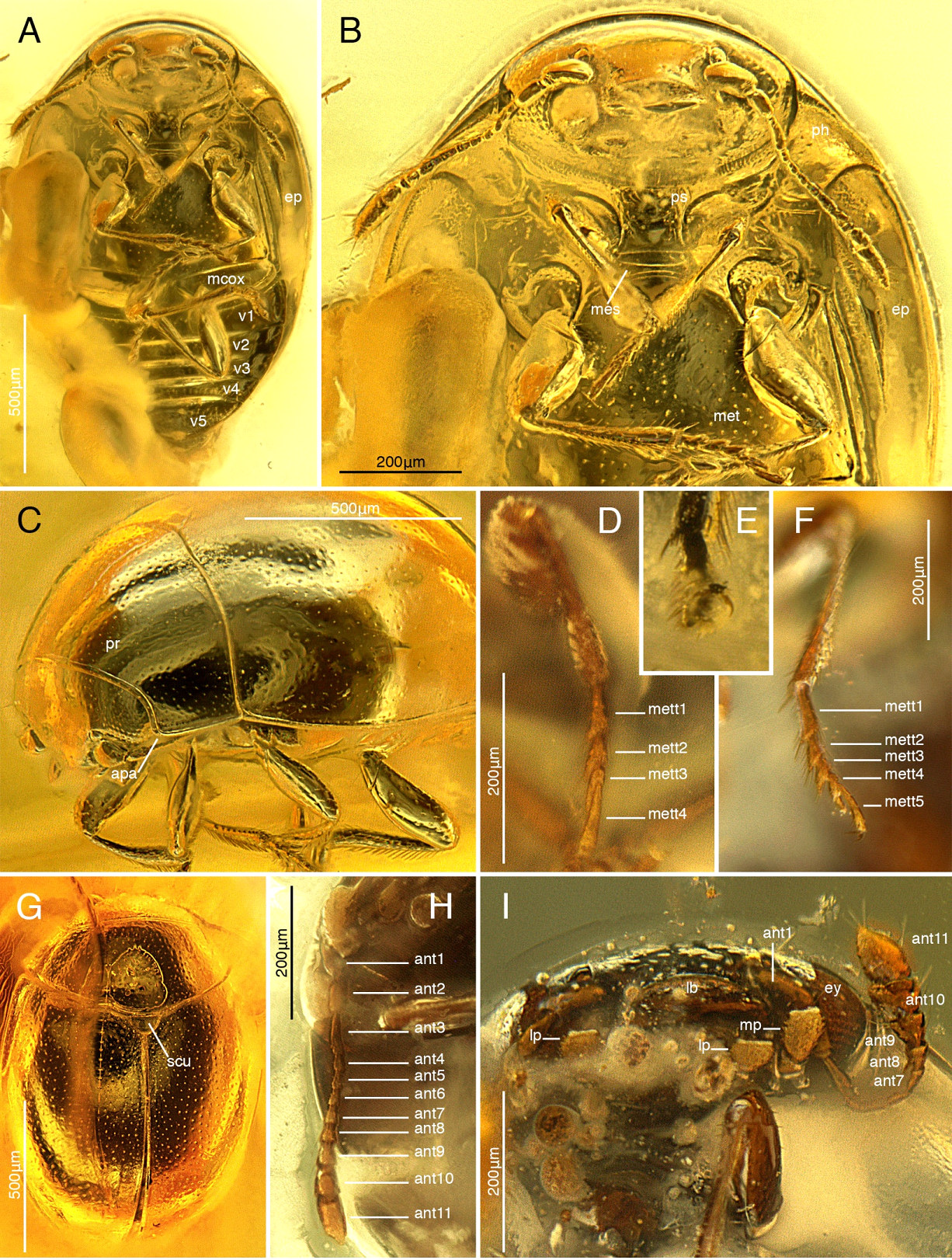|
Cucujoidea
Cucujoidea is a superfamily of beetles. This group formerly included all of the families now included in the superfamily Coccinelloidea. They include some fungus beetles and a diversity of lineages of "bark beetles" unrelated to the "true" bark beetles ( Scolytinae), which are weevils (superfamily Curculionoidea). Morphology The morphology of Cucujoidea is varied and there are no features uniting all members of the superfamily. Adults can be recognised by the procoxal cavities being internally open in most taxa, females having tarsal formula 5-5-5 and males 5-5-5 or 5-5-4 (rarely 4-4-4), females with tergite VIII concealed dorsally by tergite VII, and males with tergite X completely membraneous. Larvae have frontal arms usually lyriform, the mandible mesal surface usually with well-developed mola, a maxillary articulating area usually present, a hypopharyngeal sclerome usually present, and two pretarsal setae. Taxonomy According to a 2015 revision, the following 25 families ... [...More Info...] [...Related Items...] OR: [Wikipedia] [Google] [Baidu] |
Helotidae
Helotidae is a family of beetles, in the suborder Polyphaga. The family includes about five extant genera, ''Helota'' MacLeay, ''Neohelota'' Ohta, ''Afrohelotina'' Kirejtshuk, ''Metahelotella'' Kirejtshuk, and ''Strophohelota'' Kirejtshuk. Helotidae are found mainly in the Old World tropics and are absent from Australia and Madagascar. The antennae are clubbed on the final three segments and is retractable within grooves under the head. The wings have reduced venation with just 4 anal veins. Helotids are known to be associated with sap, fruit and flowers, and the larvae of some species are known to bore into wood in order to pupate. A few fossil genera have been described including ''Palaeohelota'' from the Lower Cretaceous (Aptian) Yixian Formation in China, ''Burmahelota,'' ''Metahelotella'' and ''Trihelota'' from the Upper Cretaceous ( Cenomanian) Burmese amber of Northern Myanmar. Another fossil genus ''Laodiscis'' placed in this family originally is now considered of uncert ... [...More Info...] [...Related Items...] OR: [Wikipedia] [Google] [Baidu] |
Lamingtoniidae
''Lamingtonium'' is the only genus in the family Lamingtoniidae, of the beetle superfamily Cucujoidea. It contains three species endemic to Australia.Lawrence, J. F., and Leschen, R. A. B. (2003). Review of Lamingtoniidae (Coleoptera: Cucujoidea) with descriptions of two new species. In ‘Systematics of Coleoptera: Papers Celebrating the Retirement of Ivan Löbl’. (Eds G. Cuccodoro and R. A. B. Leschen.) pp 905–919. (International Associated Publishers, Memoirs on Entomology, International, Volume 17.) (Associated Publishers: Gainesville, FL, USA.) The holotype of the type species was collected on at Lamington National Park, Binna Burra, Queensland under the bark of a dead tree. The adults and larvae of two species have been found associated with basidiocarps of fungi belonging to the family Polyporaceae The Polyporaceae are a family of poroid fungi belonging to the Basidiomycota. The flesh of their fruit bodies varies from soft (as in the case of the dryad's saddle ill ... [...More Info...] [...Related Items...] OR: [Wikipedia] [Google] [Baidu] |
Short-winged Flower Beetle
Kateretidae also known as short-winged flower beetles are a family of beetles in the superfamily Cucujoidea. There are 10 extant and 4 extinct genera, and at least 40 described species. They are found worldwide except in New Zealand. Adults are anthophagous, feeding on flowers, while the larvae are spermatophagous inside the flower corolla. Genera * '' Amartus'' LeConte, 1861 * '' Anamartus'' Jelinek, 1976 * '' Anthonaeus'' Horn, 1879 * '' Boreades'' Parson, 1943 * '' Brachyleptus'' Motschulsky, 1845 * '' Brachypterolus'' Grouvelle, 1913 * '' Brachypterus'' Kugelann, 1794 * '' Heterhelus'' DuVal, 1858 * '' Kateretes'' Herbst, 1793 * '' Neobrachypterus'' Jelínek, 1979 *†'' Cretaretes'' Peris and Jelínek 2019 Burmese amber, Myanmar, Late Cretaceous ( Cenomanian) *†'' Eoceniretes'' Kirejtshuk & Nel, 2008 *†'' Furcalabratum'' Poinar and Brown, 2018, Burmese amber, Myanmar, Cenomanian *†'' Lebanoretes'' Kirejtshuk and Azar 2008 Lebanese amber, Early Cretaceous (Barremia ... [...More Info...] [...Related Items...] OR: [Wikipedia] [Google] [Baidu] |
Boganiidae
Boganiidae is a family of beetles, in the superfamily Cucujoidea. Members of the family are found in southern Africa, Australia and New Caledonia. Adults and larvae are pollenivorous, feeding on the pollen of cycads and flowering plants of the families Myrtaceae, Meliaceae, Cunoniaceae and Elaeocarpaceae. '' Metacucujus'' and '' Paracucujus'' act as pollinators for cycads '' Encephalartos'' and ''Macrozamia'' respectively. This association with cycads goes back to at least the Mid-Cretaceous, with an extinct form being found with preserved cycad pollen in 99 million year old Burmese amber. Subfamilies and genera *†'' Palaeoboganium'' Liu et al. 2017 Daohugou, China, Middle Jurassic ( Callovian) *Subfamily Boganiinae Sen Gupta and Crowson 1966 **'' Afroboganium'' Endrödy-Younga & Crowson, 1986 Africa **'' Boganium'' Sen Gupta & Crowson, 1966 Australia **†'' Cretoboganium'' Cai and Huang 2018 Burmese amber, Myanmar, Late Cretaceous (Cenomanian The Cenomanian is, in the ... [...More Info...] [...Related Items...] OR: [Wikipedia] [Google] [Baidu] |
Kateretidae
Kateretidae also known as short-winged flower beetles are a family of beetles in the superfamily Cucujoidea. There are 10 extant and 4 extinct genera, and at least 40 described species. They are found worldwide except in New Zealand. Adults are anthophagous, feeding on flowers, while the larvae are spermatophagous inside the flower corolla. Genera * ''Amartus'' LeConte, 1861 * '' Anamartus'' Jelinek, 1976 * ''Anthonaeus'' Horn, 1879 * '' Boreades'' Parson, 1943 * '' Brachyleptus'' Motschulsky, 1845 * ''Brachypterolus'' Grouvelle, 1913 * ''Brachypterus'' Kugelann, 1794 * ''Heterhelus'' DuVal, 1858 * ''Kateretes'' Herbst, 1793 * '' Neobrachypterus'' Jelínek, 1979 *†'' Cretaretes'' Peris and Jelínek 2019 Burmese amber, Myanmar, Late Cretaceous (Cenomanian) *†'' Eoceniretes'' Kirejtshuk & Nel, 2008 *†'' Furcalabratum'' Poinar and Brown, 2018, Burmese amber, Myanmar, Cenomanian *†'' Lebanoretes'' Kirejtshuk and Azar 2008 Lebanese amber, Early Cretaceous (Barremian The B ... [...More Info...] [...Related Items...] OR: [Wikipedia] [Google] [Baidu] |
Erotylidae
''Ischyrus quadripunctatus'' Erotylidae, or the pleasing fungus beetles, is a family of beetles belonging to Cucujoidea containing over 100 genera. In the present circumscription, it contains 6 tribes ( Tritomini, Dacnini, Megalodacnini, Erotylini, Cryptophilini, and Languriini) and 10 subfamilies ( Cryptophilinae, Dacninae, Encaustinae, Erotylinae, Languriinae, Loberinae, Megalodacninae, Pharaxonothinae, Tritominae, and Xenoscelinae). In other words, the narrowly circumscribed Erotylidae correspond to the subfamily Erotylinae in the definition '' sensu lato''. There are doubts on the monophyly of lower ranked taxa within Erotylidae, with further phylogenetic studies requiring better sampling and studies of unexplored character sets, for example the metendosternite and penile flagellum, which are generally lacking detailed morphological studies within the Coleoptera literature. The Eroytlina taxonomy is based off traits such as their different colors and not off m ... [...More Info...] [...Related Items...] OR: [Wikipedia] [Google] [Baidu] |
Myraboliidae
''Myrabolia'' is the only genus in the beetle family Myraboliidae in the superfamily Cucujoidea. It has about 13 species, found in Australia. Adults and possibly larvae live under the bark of ''Eucalyptus'' trees. Species These species are members of the genus ''Myrabolia''. * ''Myrabolia micra'' Tomaszewska & Slipinski, 2008 * ''Myrabolia elongata'' Tomaszewska & Slipinski, 2008 * ''Myrabolia brevicornis'' (Erichson 1842) * ''Myrabolia grouvelliana'' Reitter 1878 * ''Myrabolia kioloa'' Tomaszewska & Slipinski, 2008 * ''Myrabolia pelion'' Tomaszewska & Slipinski, 2008 * ''Myrabolia lawrencei'' Tomaszewska & Slipinski, 2008 * ''Myrabolia australis'' Tomaszewska & Slipinski, 2008 * ''Myrabolia longicornis'' Blackburn 1903 * '' Myrabolia blackburni'' Tomaszewska & Slipinski, 2008 * '' Myrabolia lindensis'' Blackburn 1892 * ''Myrabolia leai'' (Grouvelle, 1911) * ''Myrabolia tasmanica ''Myrabolia'' is the only genus in the beetle family Myraboliidae in the superfamily Cucujoidea. It ... [...More Info...] [...Related Items...] OR: [Wikipedia] [Google] [Baidu] |
Coccinelloidea
Coccinelloidea is a superfamily of beetles in the order Coleoptera, formerly included in the superfamily Cucujoidea. There are more than 10,000 species in Coccinelloidea, including more than 6000 in the lady beetle family Coccinellidae. Morphology Adult Coccinelloidea have a reduced tarsal formula (each tarsus with 4 or 3 segments), hind coxae separated by more than 1/3 their width, the intercoxal process of abdominal ventrite 1 usually broadly rounded or truncate, hindwings with reduced anal veins and lacking a closed radial cell, the adeagus resting on its side when retracted and the phallobase usually reduced. Larval Coccinelloidea have a unisetose pretarsal claw, spiracles that are usually annular, and the sensory appendage of the second antennal segment usually as long as the third segment. Families The family constituency of this lineage has changed considerably over time, from as few as four or five recognized families in 1970 to 15 in 2015. * Akalyptoischiidae Lor ... [...More Info...] [...Related Items...] OR: [Wikipedia] [Google] [Baidu] |
Cavognathidae
Cavognathidae is a family of beetles, in the superfamily Cucujoidea Cucujoidea is a superfamily of beetles. This group formerly included all of the families now included in the superfamily Coccinelloidea. They include some fungus beetles and a diversity of lineages of "bark beetles" unrelated to the "true" bark .... It contains a single genus, ''Taphropiestes'' (Reitter 1875) (= ''Neocercus'' Broun, 1921, ''Cavognatha'' Crowson 1964 and ''Zeonidicola'' Crowson, 1973) with around a dozen species known from South America, Australia and New Zealand. In Australian and New Zealand species adults and larvae have been found living in bird nests, but their ecology is unclear, but they are possibly scavengers. References Cucujoidea families {{Cucujoidea-stub ... [...More Info...] [...Related Items...] OR: [Wikipedia] [Google] [Baidu] |
Hobartiidae
Hobartiidae is a family of beetles, in the superfamily Cucujoidea. There are only two known genera '' Hobartius'' (Sen Gupta & Crowson, 1966) and '' Hydnobioides'' (Sen Gupta & Crowson, 1966), with six species, five of which are native to Australia, and one species of ''Hobartius'' native to Chile and Argentina in South America. Members of the family are mycophagous, living in rotten, fungus infested logs of ''Araucaria'', ''Nothofagus'', and ''Eucalyptus,'' where they feed on the fruiting bodies of basidiomycetes Basidiomycota () is one of two large divisions that, together with the Ascomycota, constitute the subkingdom Dikarya (often referred to as the "higher fungi") within the kingdom Fungi. Members are known as basidiomycetes. More specifically, Basi .... References Cucujoidea families {{Cucujoidea-stub ... [...More Info...] [...Related Items...] OR: [Wikipedia] [Google] [Baidu] |
Pleasing Fungus Beetle
''Ischyrus quadripunctatus'' Erotylidae, or the pleasing fungus beetles, is a family of beetles belonging to Cucujoidea containing over 100 genera. In the present circumscription, it contains 6 tribes ( Tritomini, Dacnini, Megalodacnini, Erotylini, Cryptophilini, and Languriini) and 10 subfamilies ( Cryptophilinae, Dacninae, Encaustinae, Erotylinae, Languriinae, Loberinae, Megalodacninae, Pharaxonothinae, Tritominae, and Xenoscelinae). In other words, the narrowly circumscribed Erotylidae correspond to the subfamily Erotylinae in the definition ''sensu lato''. There are doubts on the monophyly of lower ranked taxa within Erotylidae, with further phylogenetic studies requiring better sampling and studies of unexplored character sets, for example the metendosternite and penile flagellum, which are generally lacking detailed morphological studies within the Coleoptera literature. The Eroytlina taxonomy is based off traits such as their different colors and not off mor ... [...More Info...] [...Related Items...] OR: [Wikipedia] [Google] [Baidu] |
Cyclaxyridae
Cyclaxyridae are a family of beetles in the superfamily Cucujoidea. The only living genus is '' Cyclaxyra'', with two species endemic to New Zealand. Other species have been named from fossils. They are also known as sooty mould beetles due to the association of ''Cyclaxyra'' with sooty mould. The extant species are mycophagous, feeding on spores, conidia, and hyphae. Genera * '' Cyclaxyra'' Broun, 1893, New Zealand, recent ** '' Cyclaxyra jelineki'' Gimmel, 2009 ** '' Cyclaxyra politula'' (Broun, 1881) * †'' Electroxyra'' Gimmel, Szawaryn, Cai and Leschen, 2019 ** ''Electroxyra cretacea'' (Wu in Wu, Li and Ding, 2018) Burmese amber, Myanmar, Late Cretaceous ( Cenomanian) * †'' Pacyclaxyra'' Tihelka, Huang and Cai, 2021 ** ''Pacyclaxyra azari'' Tihelka, Huang and Cai, 2021 Burmese amber, Myanmar, Cenomanian * †'' Neolitochropus'' Lyubarsky and Perkovsky, 2016 ** ''Neolitochropus hoffeinsorum'' Lyubarsky & Perkovsky, 2016 Bitterfeld amber, Rovno amber, Baltic amber, Europe, ... [...More Info...] [...Related Items...] OR: [Wikipedia] [Google] [Baidu] |

.jpg)

